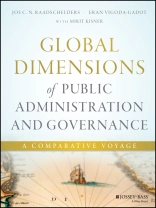A comparative, interdisciplinary examination of the mechanisms behind public administration
Global Dimensions of Public Administration and Governance is a comprehensive, comparative text on the structure and function of governments around the world. Written by two of the field’s leading public administration scholars, this book provides an interdisciplinary perspective and a global, historical, and theoretical examination of the management and governance of the modern state. Readers learn how territory, bureaucracy, and political systems influence policy and reform in over thirty countries, and how these mechanisms affect the everyday lives of citizens. This comparative approach features rich examples of how policy is shaped by culture, and how modern policy principles are filtered to fit a country’s needs and expectations. Chapters conclude with comparative analyses that help readers better-understand the role and position of government in the contemporary world, both in democratic societies and less-than-democratic environments.
Governance doesn’t happen in a vacuum. Those responsible for policy, regulation, and reform take cues from history, current events, and visions for the future to inform thinking on matters that can potentially affect a large number of everyday lives. This book illustrates the thought process, providing the necessary insight these important decisions require.
* Understand the relationship between structure and function of government
* Learn how policy is culture-dependent
* Examine the political and societal contexts of reform
* Discover the myriad forms of modern bureaucracy
The various social sciences provide valuable information and perspectives for those involved in public administration. Those perspectives converge here to form a thorough, well-rounded, examination of the success and failure possible, and the mechanisms through which they take place. Global Dimensions of Public Administration and Governance provides a detailed, wide-ranging look at how modern governments operate, how they got this far, and where they’re headed for the future.
Содержание
List of Tables and Figures xiii
Foreword xv
Acknowledgments xix
The Authors xxiii
1 Globalization and Government: Combining Global and Comparative Perspectives upon the State of Modern Government 1
Levels of Analysis and Understanding 5
Globalization 6
Combining a Global and Comparative Perspective 7
Combining the Studies of Administration and Politics 9
Audience for and Structure of This Book 10
Concluding Remarks: ‘Flying’ and Comparing across the Globe 12
PART ONE THE ORIGIN, DEVELOPMENT, AND DISSEMINATION OF GOVERNMENT: STRUCTURING TERRITORY AND ORGANIZATION 15
2 The Roots and Development of Governance, Government, and Public Administration: The Envelopment of Local Communities in Upper-Local Polities over Time 17
Types of Governing Associations 19
All Government and Governance Started Local 23
The Emergence of Territorial States as Upper-Local Polities 29
A Global Model of Government Development 32
The Development of Thinking about Government: From Political Theory to Public Administration 37
Comparing Government Models: Concluding Remarks 39
3 Structuring Governance and Government: The Layered Territorial and Bureaucratic Organization of the World 41
Territoriality and Property 42
Territorialization of the World 46
International Boundaries 48
Subnational Jurisdictions: Historical Trends 51
Subnational Jurisdictions: The Contemporary Situation 55
Bureaucracy as Organizational Structure: The Bureaucratization of the World 62
The Influence of Colonization 66
Concluding Remarks: Boundaries Creating Polities 68
4 State Making, Nation Building, and Citizenship 71
Defining State and Nation 74
State Making: Models and Explanations 82
The Separation of Organized Religion and the State: A Recent Phenomenon? 85
Nation Building: From Subjects to Citizens 89
Citizenship as Layered Phenomenon 91
A Future for State, Nation, and Citizenship? 94
5 Political-Administrative Systems and Multilevel Government 97
Basic Distinctions of Political Systems 98
Five Types of Political Systems in Relation to Political Party System 98
Unitary and Federal Systems 102
Typologies of Democratic Systems 108
Presidential and Parliamentary Systems 113
Party-Political and Bureaucratic-Prominent Systems 115
The Three Branches of Government and Core Features of Democratic Political Systems 118
The Structure of Government Departments 120
Multilevel and Multiactor Government and Governance 123
Concluding Remarks 128
6 Bureaucratic Organization and Culture 129
Defining Bureaucracy: The Influence of Max Weber and His Fears 130
Bureaucracy in the Evolution of Human Communities: The Origin of the Stereotype? 135
Societal Culture 138
Organizational Culture 146
Perceptions of Public Individuals 152
Sucking Water from Straws or Opening the Tap in the Kitchen 155
7 Organization, Management, and Policy: Comparing the Competencies of Government and Public Administration 157
The Human Side of Public Enterprise: Management, Organizations, and Behavior in Comparative Public
Administration 158
The Public Management Revolution: Comparative Views 161
Comparing the Sectors 163
The Implementation of NPM in Western Democracies 165
The United States: Measuring Performance 165
Britain: Who Comes First, the Public or the Nation? 166
The European Continent: Cultural Gaps beyond a Few Generic Similarities 167
Australia: The Administrative Responsibility Approach 168
Canada: Collaboration in Research and the Shaping of Public Policy 169
New Zealand: The Reshaping of Welfare Policy 170
Israel: Decentralization and Privatization 171
The Implementation of NPM in Other World Regions 172
Asia 173
Africa 175
Eastern Europe, Latin America, and Other Countries 177
The ‘Dinosaur Syndrome’ and the Comparative Movement: A Midrange Comment 182
The Organization and Management of Global Policy and Public Administration 184
Summary 186
8 Bureaucracy as Personnel System and Political-Administrative Relations 187
The Importance of the Personnel Function for Responsive Government 188
Defining Bureaucracy as Personnel System: Max Weber’s Juridical Perspective 191
Categories of Public Servants in a Sociological Perspective 193
Variation in the Size of the Civil Service 198
Political-Administrative Relations: Intertwinement, Politicization, and Consultation 202
Development of the Personnel Function in Developed Countries 206
The Organizational Level: Personnel Management Focused on the Organization 211
The Individual Level: The Employee as a Person with Rights, Needs, and Feelings 213
The Societal Environment: Public Pressure for Change 215
Concluding Comments 217
PART TWO MANAGING POLICIES: CONTINUITY, CHANGE, AND DIVERSITY 219
9 Traditional Government Activities I: National Defense, Police, Law and Order 221
Atrocities of Man and Nature: National Defense and Emergency Management 221
France: Europeanization, Professionalization, and the End of Conscription 222
Israel: Militarized Society or Civilianized Military? 225
United States: Resting on Its Laurels—FEMA’s Vicissitudes from Ignominy to Luster and Vice Versa 231
Internal Security: Enforcing Law and Order 236
Colombia: A Quagmire of Guerillas, Drug Cartels, and Paramilitaries—Demilitarization Bogging Down 237
South Africa: Post-Apartheid Community Policing—Transmuting the Police Force to a Police Service 244
Britain: Integrating Offender Management—Performance, Contestability, and Amalgamation 248
The Judiciary System: One State under the Rule of Law 254
The People’s Republic of China: The Silent Revolution— Rationalization, Modernization, and Constitutionalization 254
The UN Security Council: Reforming a Perplexed Peacekeeper 259
Germany: A Nonimmigration Nation, Rife with Immigrants—Article 16 of the Basic Law in the Limelight 264
Comparing Defense, Police, and Judiciary across Nations 268
10 Traditional Government Activities II: Economy, Finance, and Taxation Systems 275
Economy and Finance 276
Romania: Restructuring Agriculture in a Transition Economy 276
Spain: Faltering Growth, Wavering Employment Rates—An Economy Veering between Prosperity and Downspin 279
Greece: Footing the Bill for Laxity during the Ostensive Boom Years 283
Iran: The Paradox of Plenty—Replete with Hydrocarbon Reserves and Yet in a Pickle 287
Tax Reforms: Taking for Giving 292
Denmark: Searching for the Magic Bullet to Reduce Income Tax
Pressures and Labor Costs 292
Belgium: Spurring Unemployed and Low Earners into Labor 295
Estonia: Going Flat—An Avant Garde That Has Become a Common Practice 298
Comparing Economy, Finance, and Taxation Systems across Nations 302
11 Social-Economic Services: Energy Management, Planning and Zoning, Industry and Trade 311
Energy Management 312
Russia: The Kremlin’s Bear Hug 312
Germany: Renewable Energy Sources Come to the Throne 315
California: A Calamity Precipitated by Deregulation 317
India: A Public Leopard with Private Spots 319
Planning and Zoning 322
Zimbabwe: Land Reform in a Ruptured Ex-Colony 322
New Zealand’s Resource Management Act: A Spearhead of Sustainable Development 324
Brazil: Frontiers, Landlords, Squatters, and a Vacillating Government 327
Laos: The Desperate Ecocide of the Poor 330
Industry and Trade 332
Morocco: Liberalization of Trade and Tariff Reforms 333
The Czech Republic: Cars, Motors, and Foreign Direct Investment (FDI) 335
Canada: Trade Agreements with the Northern Empire 338
Mexico: The Poor Cousin of NAFTA’s Triad 341
Comparing Energy Management, Planning and Zoning, and Industry and Trade across Nations 344
12 Welfare Services and Policies: Health Care, Education, and Social Services 349
Health Care 350
Singapore: The ‘3Ms’ triad—Medisave, Medishield, and Medifund 351
The Netherlands: Dutch-Managed Competition—Getting the Full Monty 354
Argentina: Promoting a Health Care System under a Sick Economy 357
Australia: A Public-Private Seesaw 360
Education 364
Wisconsin: Vouchering Together—Unlikely Allies in Milwaukee 364
France: Contractualization au Courant—Le Central Unleashes Higher Education 368
The People’s Republic of China: Between a Soviet Rock and a Western Hard Place—Higher Education on the Horns of a Dilemma 372
Britain: New Right, New ERA, Old Cleavages 376
Social Security 381
Chile: Social Security Gone Outright Private 381
Japan: A Double-Edged Sword—Super-Aged, Poorly Funded 386
Poland: Farewell Redistribution, Hello Funded Defined Contribution 390
Sweden: Transforming Corporatism and Remodeling Labor Market Policies 394
Comparing Health Care, Education, and Social Services across Nations 398
13 A Vision for Comparative Theory and Practice: Horizons of the Comparative Voyage 407
Comparison in Motion: Divergence and Convergence across Time and States 409
The Comparative Approach in Service of Interconnectedness, Emulation, and Policy Transfer 411
Comparative Public Administration and Governance: Between Transfer and Diffusion 414
Horizons for Comparative Public Administration and Governance 418
Summary and Final Remarks 421
Appendix One Structural Similarities—Cultural Differences: The Need for and Development of
Comparative Government Studies 427
The Function of Comparison in Society and in the Social Sciences 428
The Importance of Comparison in the Study of Public Administration 430
Geographical Fragmentation of Comparative Research and Understanding 432
Substantive Fragmentation of Comparative Research and Understanding 435
Methodological and Epistemological Fragmentation of Comparative Research and Understanding 440
The Development of Comparative Public Administration 443
Appendix Two Motives, Types and Theories, Methods for, and Challenges of Comparative Perspectives 449
Motives for Comparison 451
Theories, Methods, and Types of Comparison 454
Approaches to and Theories in Comparative Public Administration and Governance 454
Three Basic Methods of Comparison 458
Types of Comparisons 461
Challenges of Comparative Research 464
Conceptual, Linguistic, and Semantic Problems 465
Theoretical and Methodological Problems 468
Research Technical Problems 472
Problems of Application 473
Bibliography 475
Index 525
Об авторе
JOS C.N. RAADSCHELDERS is Professor and Associate Director for Faculty Development at the John Glenn School of Public Affairs, The Ohio State University. A prolific, well-known scholar and teacher globally, Raadschelders’ work is widely published in books and in the leading journals in the field. He is a Fellow of the National Academy of Public Administration.
ERAN VIGODA-GADOT is Professor, founder and Director of the Center for Public Management and Policy (CPMP) at the School of Political Science, University of Haifa, Israel. With expertise in Public Administration, Public Management, and Organizational Behavior, Vigoda-Gadot is well known nationally and internationally. He has more than 170 scholarly publications as well as 12 books, and the voyage still continues.












